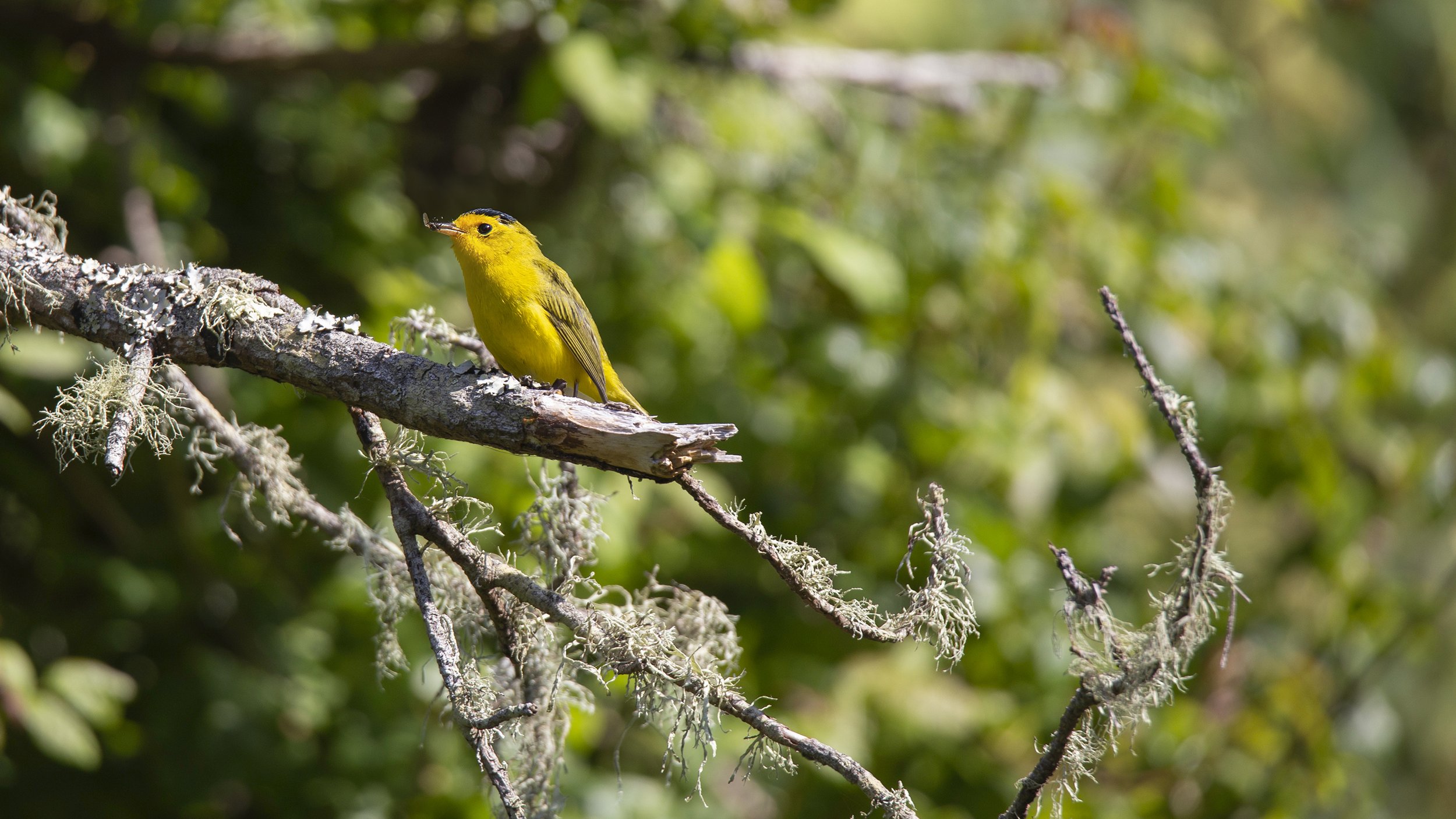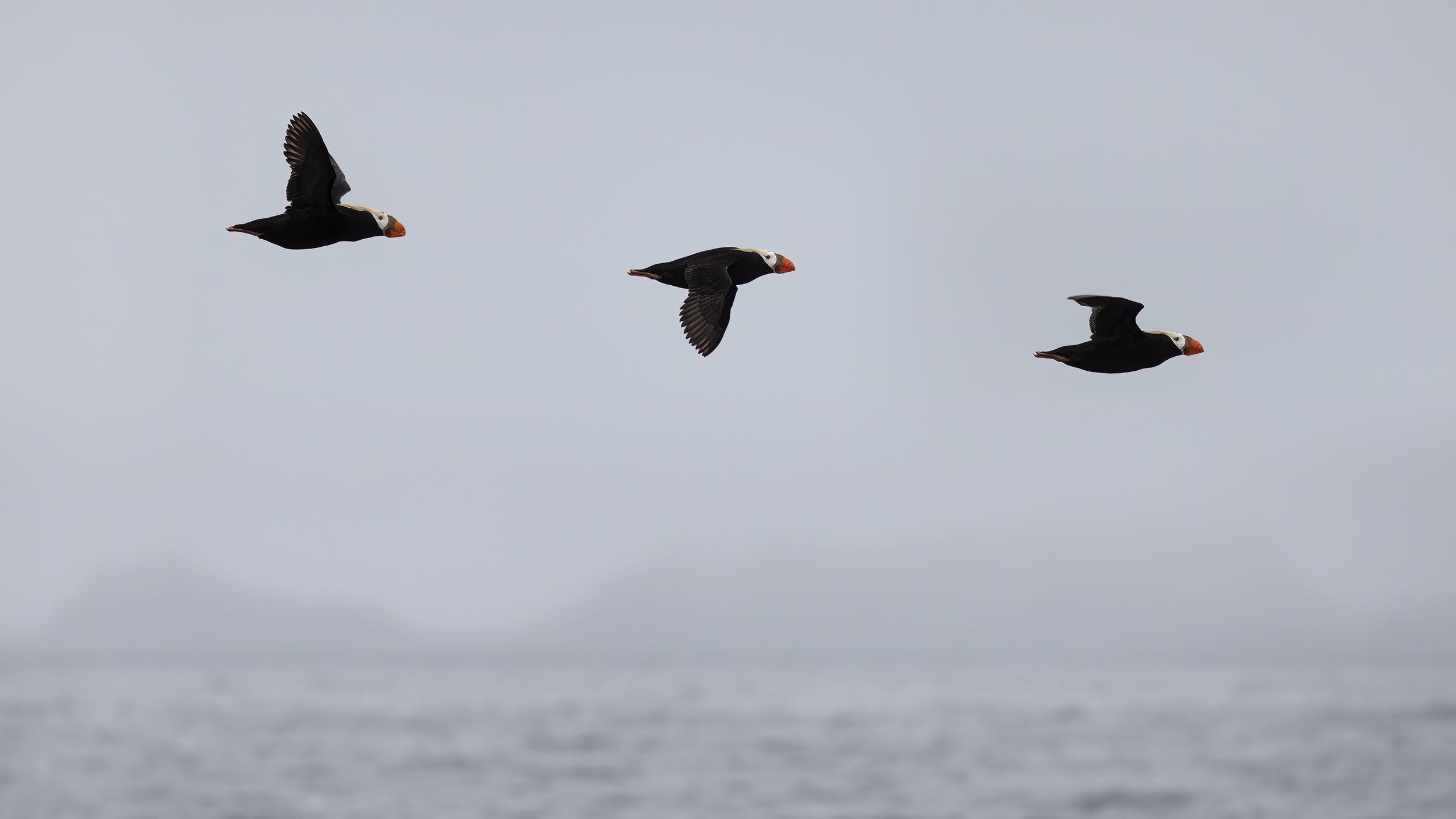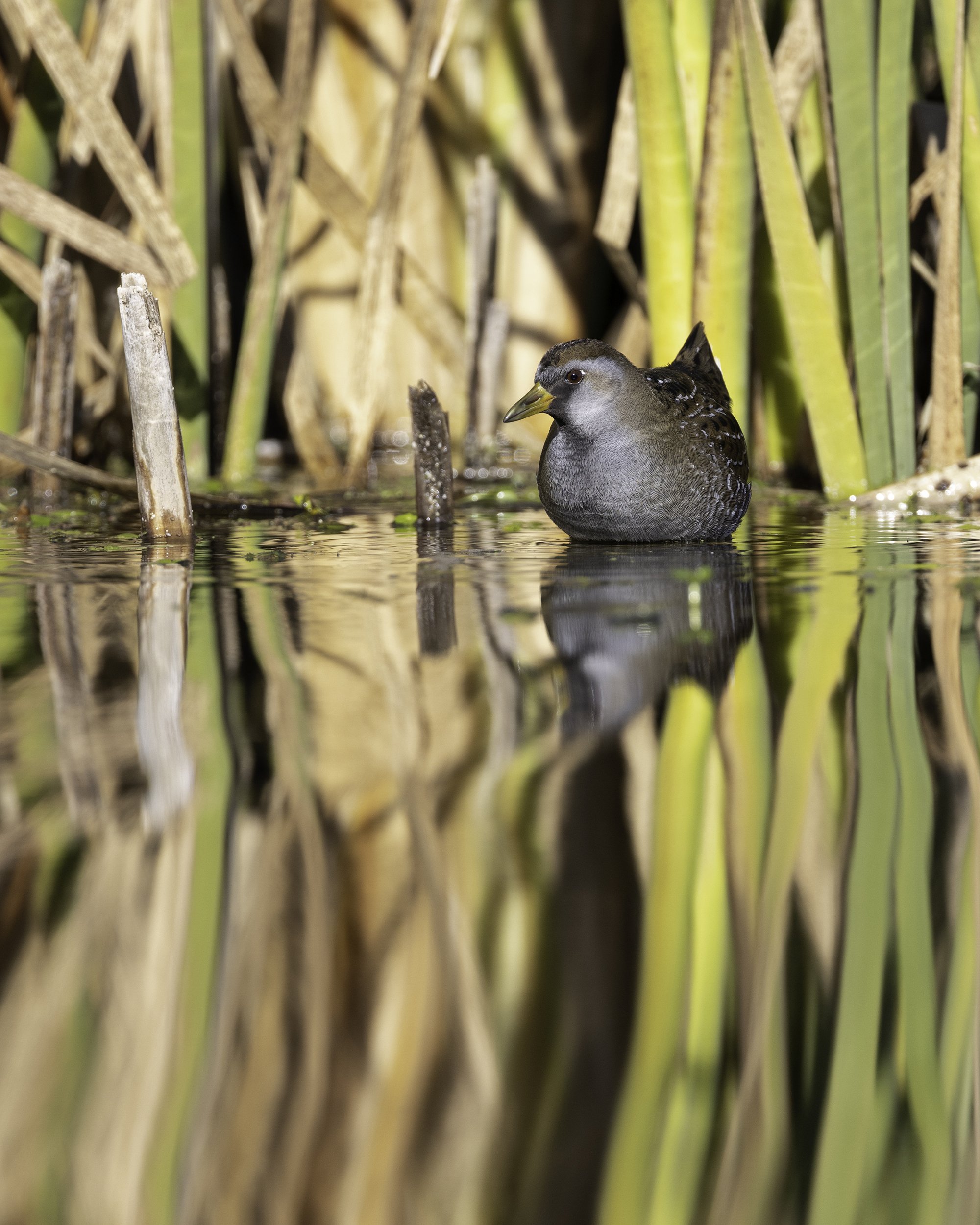
Wilson’s warbler, Point Reyes National Seashore: 600mm | ƒ6.3 | ISO 200 | 1/320 sec
Birds of California
In an environment where disorder is ruthlessly eliminated, birds epitomize pure freedom.
No matter the habitat, birds are a constant background presence in our lives, and yet we’re so often oblivious to their rhythms and behavior. They are, however, the thread that connects everything in the natural world.
Read the field notes
Western snowy plover, Point Reyes National Seashore: 500mm | ƒ7.1 | ISO 640 | 1/1000 sec
Red-tailed hawk, Point Reyes National Seashore: 600mm | ƒ7.1 | ISO 100 | 1/320 sec
Great horned owl, Point Reyes National Seashore: 600mm | ƒ6.3 | ISO 100 | 1/500 sec
Great blue heron with a gopher, Point Reyes National Seashore: 600mm | ƒ6.3 | ISO 400 | 1/1250 sec
Everyone knows that herons eat fish, but who knew they also eat rodents? It may not be pleasant to watch them spear gophers and swallow them whole, but it’s all part of the circle of life and I wanted to capture that surprising behaviour.
White-headed woodpecker, Tahoe National Forest: 500mm | ƒ7.1 | ISO 4000 | 1/1000 sec
Rufous hummingbird nesting, Marin County: 500mm | ƒ7.1 | ISO 5000 | 1/5 sec
Audubons warbler, Cosumnes River Preserve: 500mm | ƒ8 | ISO 500 | 1/1000 sec
Black Turnstone, Point Reyes National Seashore: 500mm | ƒ8 | ISO 800 | 1/1600 sec
Tufted Puffins, Farallon Islands National Wildlife Refuge: 324mm | ƒ6.3 | ISO 160 | 1/2000 sec
American wigeon coming in to land, Point Reyes National Seashore: 500mm | ƒ7.1 | ISO 500 | 1/1600 sec
Red-shouldered hawk, Point Reyes National Seashore: 600mm | ƒ6.3 | ISO 100 | 1/200 sec
Sometimes I search endlessly for wildlife, and on other days it finds me. On this occasion I was hiking past these bushes with the sensation of being watched, and there it was: a red-shouldered hawk right beside me.
California quail chick, Point Reyes National Seashore: 600mm | ƒ6.3 | ISO 200 | 1/200 sec
Turkey vulture and common raven with a California sea lion carcass, Point Reyes National Seashore: 450mm | ƒ7.1 | ISO 400 | 1/1600 sec
Black-footed albatross, Monterey Bay: 400mm | ƒ6.3 | ISO 200 | 1/2000 sec
California condor, Pinnacles National Park: 500mm | ƒ8 | ISO 400 | 1/1600 sec
Black-necked stilt, Bothin Marsh: 500mm | ƒ7.1 | ISO 800 | 1/1000 sec
Female northern harrier, Point Reyes National Seashore: 600mm | ƒ6.3 | ISO 400 | 1/1000 sec
Pileated woodpecker, Lake Lagunitas: 500mm | ƒ8 | ISO 1600 | 1/1000 sec
Greater white-fronted goose, Cosumnes River Preserve: 500mm | ƒ7.1 | ISO 320 | 1/800 sec
Semipalmated Plover, Point Reyes National Seashore: 220mm | ƒ8 | ISO 500 | 1/1600 sec
Juvenile cooper's hawk, Point Reyes National Seashore: 600mm | ƒ6.3 | ISO 2500 | 1/1000 sec
Sora, Point Reyes National Seashore: 500mm | ƒ8 | ISO 400 | 1/1000 sec
Anna's hummingbird, Larkspur: 118mm | ƒ8 | ISO 1600 | 1/800 sec
Bald eagles, Jenner: 600mm | ƒ6.3 | ISO 400 | 1/1000 sec
Heermann’s gulls, Point Reyes National Seashore: 500mm | ƒ8 | ISO 400 | 1/1000 sec
Sandhill cranes, San Joaquin County: 300mm | ƒ5.6 | ISO 160 | 1/1000 sec
Marsh wren, Cosumnes River Preserve: 600mm | ƒ6.3 | ISO 400 | 1/640 sec
Burrowing owl, Point Reyes National Seashore: 600mm | ƒ7.1 | ISO 250 | 1/800 sec
Mallard duckling, Marin County: 500mm | ƒ8| ISO 400 | 1/1600 sec
Common murre, Monterey Bay: 500mm | ƒ8 | ISO 500 | 1/2500 sec
Western screech-owl, Briones Regional Park: 500mm | ƒ7.1 | ISO 3200 | 1/60 sec
American white pelican, Corte Madera Marsh Ecological Reserve: 500mm | ƒ7.1 | ISO 640 | 1/1000 sec
American white pelican, San Pablo Bay Wildlife Area: 500mm | ƒ7.1 | ISO 250 | 1/2000 sec
Sanderling, Point Reyes National Seashore: 500mm | ƒ7.1 | ISO 500 | 1/2500 sec
Barn owl, Point Reyes National Seashore: 500mm | ƒ8 | ISO 1600 | 1/500 sec
Common ravens, Pinnacles National Park: 400mm | ƒ6.3 | ISO 1250 | 1/1600 sec
Wild turkey, Tuolumne County: 450mm | ƒ7.1 | ISO 800 | 1/1000 sec
Juvenile peregrine falcon, Point Reyes National Seashore: 600mm | ƒ7.1 | ISO 100 | 1/250 sec
Brandt’s cormorant, Moss Landing State Beach: 500mm | ƒ8 | ISO 250 | 1/1000 sec
Dark-eyed junco, Sanborn County Park: 500mm | ƒ8 | ISO 1250 | 1/500 sec
Long-billed curlew, Point Reyes National Seashore: 600mm | ƒ10 | ISO 200 | 1/640 sec
Mourning dove, Tolay Lake Regional Park: 500mm | ƒ7.1 | ISO 640 | 1/1600 sec
White-tailed kite, Point Reyes National Seashore: 600mm | ƒ6.3 | ISO 400 | 1/2500 sec
Western wood-pewee, Tahoe National Forest: 500mm | ƒ8 | ISO 1600 | 1/1000 sec
I was deep in the woods around Lake Tahoe, photographing black bears, when I noticed this delicate scene unfolding right beside me. The wood-pewee parents were working overtime to bring insects home to their growing family. It took a lot to draw my eyes away from the bears foraging behind me, but this moment was worth it.
Barn swallow feeding juvenile, Moss Landing: 500mm | ƒ8 | ISO 1000 | 1/2000 sec
California quail, Point Reyes National Seashore: 500mm | ƒ7.1 | ISO 500 | 1/1600 sec
Field Notes
The air was damp and still as I clambered through the boulder-strewn narrows of Bear Gulch. It was a cool December morning in the shadow of the canyon walls, but warm light was creeping down the rocks to meet me in my ascent, and I knew from previous visits to Pinnacles National Park, that I’d be sweating in the sun soon enough. I wasn’t here for the weather though—I was here for California’s most iconic endangered bird: the California condor (Gymnogyps californianus).
Somewhere above me, in a skyline torn with spires and rugged crags, the birds I came to see were expecting things to warm up too. With nearly ten-foot wingspans and a preference for gliding, California Condors wait for the sun to do its part, warming the ground and creating the thermals they love to cruise on.
The trail steepened as I climbed into the High Peaks. The terrain grew starker—stone fractured by ancient tectonics, drop-offs that felt like they belonged to another era. My thoughts were focused on each step when a shadow crossed the path. I looked up, and there it was: my first sighting of a condor drifting into view. No wing tags, just a gray head, and effortless grace; a juvenile, born in the wild.
The sight of a condor was enough to stop me in my tracks, but that detail—the lack of wing tags—carried extra significance. For a species once declared extinct in the wild, an untagged bird meant something extraordinary: a bird raised by condors, not conservationists. It was evidence of a successful breeding program. It meant survival.
Thankfully, that lone juvenile wasn’t the only condor I saw that day—Pinnacles remains one of the best places in the state to observe these endangered birds in flight. Higher up, where vast panoramic vistas opened up, there were plenty more: massive silhouettes socializing on a distant outcrop, framed by cloudless blue, while others soared above. The highlight was when a tagged male, number 89, flew close by without flapping his wings once. I was glad I had my camera in hand; through the lens, I could clearly see his bright red head, piercing eyes, and strong beak as he passed.
In the late afternoon sun, I was feeling tired, achy, and sunburnt. My camera pack was starting to feel heavy on my shoulders and I knew it was a long way home. I began my descent on the Condor Gulch Trail elated by the day’s sightings. But there was more to come. On a distant ledge, two more condors came into view, engaged in their own breeding program, working on another generation of these incredible birds. A scavenger species reborn. I felt like I’d witnessed life after death.
“I came late to the love of birds. For years I saw them only as a tremor at the edge of vision.” That line from J.A. Baker’s The Peregrine captures a truth I’ve come to recognize in myself. For most of my life, I paid almost no attention to birds. They were too ubiquitous to notice—background noise to a busy life. However, once I picked up a camera and started exploring the natural world more intentionally, I found myself becoming curious about the most visible animals around me.
My interest in birds wasn’t a sudden transformation, but rather a steady accumulation of questions: What was that call? Why did that bird freeze mid-hop? Why are they exerting so much energy in a seemingly random way? It wasn’t until I read What the Robin Knows by Jon Young that things started to fall into place. The book doesn’t teach identification—it teaches awareness. It shows how birds are constantly conversing with their environment. Their calls reveal the presence of predators, the time of day, and even the weather.
Over time, I began to notice more consistent behavior in many common California birds—patterns that revealed their intelligence and purpose. The way a California quail (Callipepla californica), our state bird, will stand guard on a fence post while others forage ground. Or how red-winged blackbirds (Agelaius phoeniceus) would chase far larger raptors from their nest sites. I’ve never been an expert at decoding the nuance of their activity, but where I once (stupidly) heard mindless chirping, I now heard alarms, declarations, and gossip. It felt like a world was being unlocked.
“There are currently very close to ten thousand species of birds in the world, both beautiful and improbable,” writes Tim Birkhead in Bird Sense, “and they have contributed more to the study of zoology than almost any other group of animals.” It’s a number that speaks to both scale and mystery. And I was only just beginning to grasp how much there was to learn. Thankfully, California is one of the best places in the world for birdwatching, wildlife photography, and appreciating bird diversity.
California’s avian diversity is incredible, and from sea cliffs to redwood forests, and alpine meadows to urban parks, the landscape is a patchwork of habitats filled with stories told in feathers, flight, and song. In Why Birds Matter, Jonathan Franzen writes, “To survive in so many different habitats … bird species have evolved into a spectacular diversity of forms.”
Behavior is another way to illustrate how varied our bird species are. From the way a Caspian tern (Hydroprogne caspia) enters the water like a dart, to how a pileated woodpecker (Dryocopus pileatus) strikes a tree trunk with seismic force, their skill sets are astonishingly diversified. Sometimes even a single species can demonstrate range. Consider the great blue heron (Ardea herodias).
With their massive wings and prehistoric silhouettes, great blue herons are hard to miss. And yet, for a long time, I casually assumed I understood their role in the ecosystem: they wade in shallow water and hunt fish. That’s what “wading birds” do. I regularly watched one heron in particular, patiently snatching sticklebacks from the shallows at a nearby lagoon. Less than a mile away, however, I spotted another heron doing something entirely different: stalking the surf zone, plucking mole crabs from the receding waves with startling accuracy.
Later that same day, in a grassy field not far from either water source, I saw a third heron hunting gophers. Its long neck lunged forward and emerged from the undergrowth with an unfortunate mammal, promptly swallowing it whole. It was impressive. A little gruesome. And completely unexpected. In a single afternoon, within a single square mile, I witnessed the same species use three distinct hunting strategies to pursue three entirely different prey.
With such astonishing variety, what unites birds? Despite the vast differences in size, shape, behavior, and geography, there’s one feature that defines a bird more than any other: the feather. As David Attenborough explains in Life on Earth, “Almost all the characteristics that distinguish birds from other animals can be traced one way or another to the benefits brought by feathers. Indeed, in the modern world, the very possession of a feather is enough to define a creature as a bird.”
Feathers are made of keratin—the same substance as our fingernails or a reptile’s scales—but their construction is intricate. Each feather has a central shaft lined with hundreds of filaments, each of those fringed with barbules that hook together like a zipper. A bird the size of a tundra swan (Cygnus columbianus) might have 25,000 feathers—each one marvelously engineered for insulation, flight, or display.
Unfortunately, however, feathers are one of the reasons birds have suffered at the hands of humans, with an enthusiasm for wearing dead birds often outstripping our enthusiasm for observing living ones. When I think about what makes birds so fascinating, there are endless reasons: the mysteries of flight, the question of how they migrate thousands of miles, their constant presence in our daily lives, or their sheer beauty. But, as Michelle Nijhuis writes in Beloved Beasts, “Maybe it’st hat birds always seem especially in need of sanctuary from ourselves.”
One species of bird close to my home has come dangerously close to the brink of extinction. This has nothing to do with feathers and more to do with habitat loss and predation. At Point Reyes National Seashore, charismatic species like tule elk, bobcats, and owls tend to steal the spotlight. But, scattered along the beach, if you're paying very close attention, you might spot something much smaller, well camouflaged, and silent as a shadow darting across the sand. A federally threatened bird with a tiny population: the western snowy plover (Anarhynchus nivosus nivosus).
Snowy plovers are easy to overlook. About the size of a sparrow, these pale sand-colored birds blend in almost perfectly with their surroundings. You don’t see them until they move—and sometimes not even then. My quest to photograph some wasn’t an easy one. I walked the beaches, scanning the edges of the dunes and waiting for signs of movement. When I finally spotted one, I lay low and watched from afar with a long lens, giving them plenty of space. If a plover noticed me, it often turned its back, using its camouflaged upper feathers to vanish again into the sand.
During their breeding season, their vulnerability becomes even more pronounced. The park service has stepped in with habitat restoration projects, roping off critical dunes and placing wire enclosures over eggs to protect them from opportunistic ravens (Corvus corax). I’ve never found a nest, and I haven’t seen any chicks. And honestly, I’m okay with that. Photographing these birds is rewarding, but a successful breeding season away from people—even well-intentioned ones like me—is the better outcome. Some stories are best left unwatched, especially when the ending might be survival.
Birds experience the world in ways we can barely comprehend. Their senses, honed over millions of years, extend beyond the limits of our perception. In Bird Sense, Tim Birkhead explains that while human hearing begins to falter at sound intervals of a tenth of a second, many birds effortlessly parse much finer temporal detail in song. “It is as if they have the auditory equivalent of a slow-motion option in their brain.”
And then there’s magnetoreception—a bird’s ability to navigate using the Earth’s magnetic field. Unlike light or sound, magnetic waves pass straight through body tissue. Birds seem able to detect them via chemical reactions inside individual cells, allowing them to orient and travel with astonishing precision. This, too, is part of their reality but remains largely inaccessible to us.
In some ways, birds feel profoundly other. Yet in others, they offer unexpected kinship.
When our son Gavin turned six months old, Allison and I gave him his own room—a sanctuary where he could sleep, play, and grow. As we assembled his crib and decorated the nursery, a parallel drama unfolded just outside the window. A rufous hummingbird (Selasphorus rufus) was building a nursery of her own: a tiny nest in the crook of a pine branch.
If she was weary from her long migration, she didn’t show it. She worked tirelessly, ferrying moss, feathers, and spider silk. She pressed and shaped each addition with precision, weaving a structure no larger than a walnut. Gavin and I watched her together, our heads tilted toward the same tree.
Then came the storms. One atmospheric river after another pounded the Bay Area. The little nest swayed in the wind, and for days we saw no sign of its architect. When the clouds finally cleared, the nest remained—intact but abandoned. We hoped she had found shelter farther north, somewhere safer to raise her young.
Spring returned, as it always does. Anna’s hummingbirds (Calypte anna) hovered around our balcony. Ducklings (Anas platyrhynchos) paddled across the pond. Up in the pine’s highest branches, a family of crows (Corvus brachyrhynchos) moved in. A few weeks later, we noticed activity near the tiny nest again. A new tenant had arrived: a pair of house finches (Haemorhous mexicanus), salvaging the site for their own brood. Gavin and I kept a respectful distance as we watched the female build, the male looking on with nervous energy. When she began spending more time in the nest, I backed away, remembering those quiet final days before our own child arrived.
National Geographic reports that even a glimpse of nature—a patch of grass, a tree beyond a window—can lower stress and improve recovery from illness. If that’s the case, then how much better off would we be as a society if we paid more time to the birds we’re lucky enough to share this planet with?
To license images or order prints, please get in touch.















































